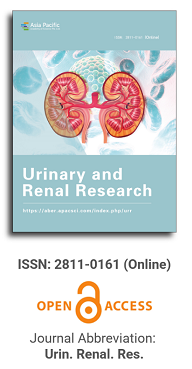
Asia Pacific Academy of Science Pte. Ltd. (APACSCI) specializes in international journal publishing. APACSCI adopts the open access publishing model and provides an important communication bridge for academic groups whose interest fields include engineering, technology, medicine, computer, mathematics, agriculture and forestry, and environment.
Effect of dynamic monitoring based on renal function indexes on the efficacy and safety of vancomycin in the treatment of MRSA pneumonia in elderly patients
Vol 4, Issue 1, 2023
Download PDF
Abstract
Objective: To explore the feasibility of dynamic monitoring based on renal function indexes to evaluate the efficacy and safety indexes of vancomycin in the treatment of methicillin-resistant Staphylococcus aureus (MRSA) pneumonia in elderly patients, and to provide reference for the evaluation of the feasibility of vancomycin pharmaceutical care. Methods: 118 elderly patients with MRSA pneumonia treated from March 2017 to February 2020 were divided into routine treatment group (n=56) and intervention group (n=62). Patients in the routine treatment group were treated with routine vancomycin, while patients in the intervention group flexibly adjusted the dosage of vancomycin according to the dynamic monitoring of endogenous creatinine clearance (CCR), blood creatinine (SCR) and urea nitrogen (BUN). The changes of CCR, SCR and BUN and the difference of vancomycin serum. Valley concentration were compared between the two groups before and after vancomycin treatment, and the correlation between the changes of CCR, SCR and BUN and vancomycin serum. Valley concentration was analyzed to explore the difference of clinical efficacy and adverse reaction rate between the two groups after treatment. Results: Two factor analysis of variance showed that the serum trough concentrations of SCR, bun and vancomycin in the intervention group were significantly lower than those in the routine treatment group, but the CCR value was significantly higher than that in the routine treatment group (P<0.05). Pearson correlation analysis showed that the serum. Valley concentration of vancomycin was negatively correlated with CCR (r=-0.473), but positively correlated with SCR (r=0.537) and bun (r=0.619) (P < 0.05) more.
Keywords
References
- Lakhundi S, Zhang K. Methicillin-resistant Staphylococcus aureus: molecular characterization, evolution and epi- demiology[J]. Clin Microbiol Rev, 2018,31(4): e00020- 18.
- Galán- Sánchez F, Pérez- Eslava M, Machuca J, et al. Staphylococcus aureus carriage in older populations in community residential care homes: prevalence and molec- ular characterization of MRSA isolates[J]. Enferm Infecc Microbiol Clin, 2019, 37(3): 172- 175.
- Holmes NE, Tong SY, Davis JS. Treatment of methicillin-resistant Staphylococcus aureus: Vancomycin and beyond [J]. Semin Respir Crit Care Med, 2015, 36(1):17-30.
- Liu Junna, Wang Chunjuan, Fu guopeng Clinical characteristics and drug resistance of MRSA pneumonia [J] Clinical medicine research and practice, 2017, 2 (26): 34-35
- Álvarez R, López Cortés LE, Molina J, et al. Optimizing the clinical use of vancomycin[J]. Antimicrob Agents Che- mother, 2016, 60(5): 2601-9.
- Li Guanghui Consensus of Chinese experts on clinical dosage of vancomycin [J] Chinese Journal of infectious diseases, 2012 (11): 641-646
- Velez JCQ, Obadan NO, Kaushal A, et al. Vancomycin-associated acute kidney injury with a steep rise in serum cre- atinine[J]. Nephron, 2018, 139(2): 131- 142.
- Qu Jieming, Cao Bin. Guidelines for the diagnosis and treatment of community-acquired pneumonia in Chinese adults (2016 Edition) [J] Chinese Journal of tuberculosis and respiration, 2016, 39 (4): 253-279
- Zhang Jing, Zhang Qi, Geng Jing. Analysis of epidemiological change trend of MRSA in hospitalized patients from 2012 to 2017 [J] Chinese Journal of nosocomial infection, 2018, 28 (19): 3033-3036
- Wang Bin, Shi Youquan, Si Yiran, et al Research Progress on epidemiological characteristics of methicillin resistant Staphylococcus aureus [J] Journal of Dalian Medical University, 2013, 35 (2): 183 - 187
- Mei H, Wang J, Che H. The clinical efficacy and safety of vancomycin loading dose: a systematic review and meta- analysis[J]. Medicine (Baltimore), 2019, 98(43): e17639.
- Gong Xingjun Detection of vancomycin plasma concentration and its guiding significance for clinical medication [J] China’s health industry, 2017, 14 (9): 137-138
- Vandecasteele SJ, De Vriese AS, Tacconelli E. The phar-macokinetics and pharmacodynamics of vancomycin in clinical practice: evidence and uncertainties[J]. J Antimi-crob Chemother, 2013, 68(4): 743-748.
- Xia Lan, Ye Qianqian, Wu Anhua, et al. Effects of renal hyperfunction and hypoproteinemia on the concentration of vancomycin Valley [J] Chinese Journal of antibiotics, 2020, 45 (9): 940-946
- Zhou Qingtao, He Bei, Shen Ning, et al Effect of renal clearance on vancomycin Valley concentration in elderly patients with severe pneumonia [J] Chinese Journal of tuberculosis and respiration, 2016, 39 (2): 105 - 109
- Xie Ling, Liu Daihua, Huang Yikun Clinical intervention effect of vancomycin in patients with renal injury [J] Guangxi Medical Journal, 2018, 40 (19): 2272-2274
- Moffett BS, Morris J, Kam C, et al. Vancomycin associat- ed acute kidney injury in pediatric patients[J]. PLoS One, 2018, 13(10): e0202439.
- Arihan O, Wernly B, Lichtenauer M, et al. Blood urea ni- trogen (BUN) is independently associated with mortality in critically ill patients admitted to ICU[J]. PLoS One, 2018, 13(1): e0191697.
Supporting Agencies
Copyright (c) 2023 Feng Hui

This work is licensed under a Creative Commons Attribution-NonCommercial 4.0 International License.

This site is licensed under a Creative Commons Attribution 4.0 International License (CC BY 4.0).
.png)
Prof. Wei-Yen Hsu
National Chung Cheng University, Taiwan

